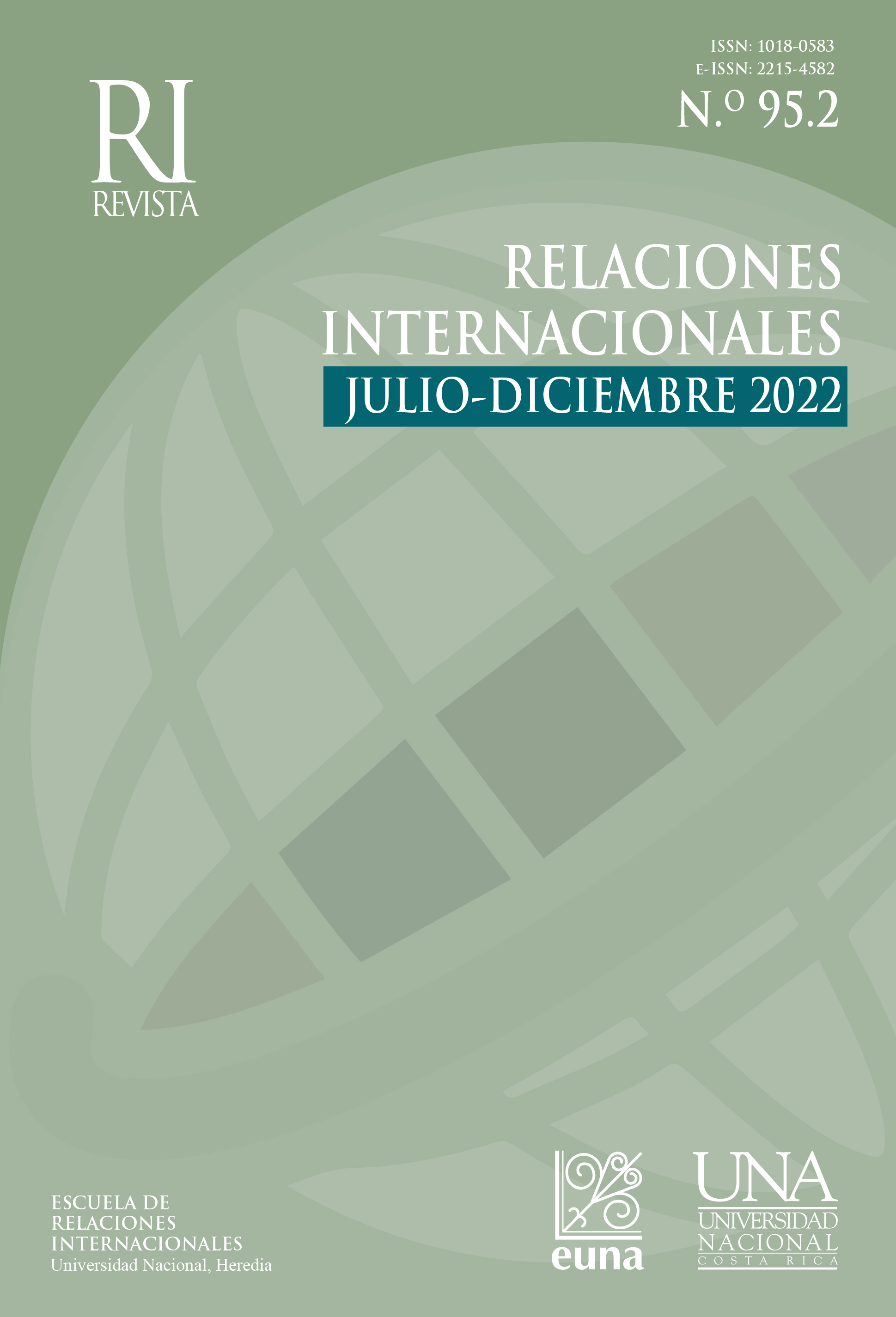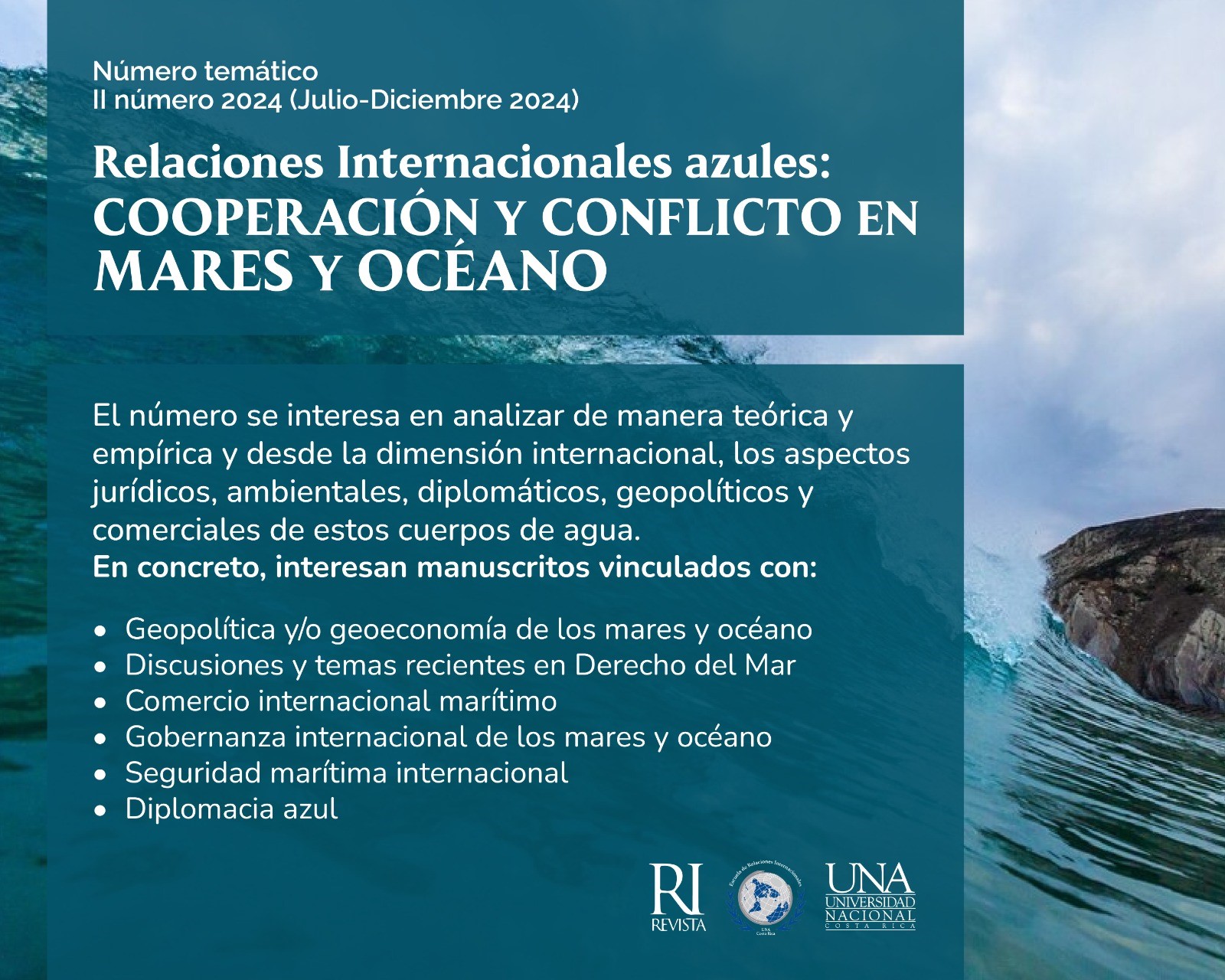La pandemia por COVID-19 y el cambiante panorama de las remesas en Haití
DOI:
https://doi.org/10.15359/ri.95-2.6Palabras clave:
Brasil, Chile, COVID-19, Haití, migración sur-sur, remesasResumen
En 2020, los análisis de instituciones multilaterales predijeron que la pandemia por COVID-19 obstaculizaría las transferencias de remesas a la región de América Latina y el Caribe, no obstante, se experimentaron aumentos constantes en 2020 y 2021. La economía de remesas de Haití ha mantenido, en gran medida, su vitalidad, ayudando a las familias a superar múltiples crisis. A partir de obtenidos datos en un estudio sobre el impacto de la COVID-19 en los hogares haitianos y datos de remesas del Banco Central de Haití, este artículo examina el panorama cambiante de las remesas de Haití, con especial atención a los nuevos flujos migratorios hacia América Latina que han surgido desde el terremoto de enero de 2010. Así, se toma en cuenta el aumento de la migración haitiana a Brasil y Chile, entre otros países, durante 2010 y 2020, es que nos preguntamos: ¿Qué papel han jugado las remesas provenientes de América del Sur en los hogares haitianos antes y durante la pandemia por COVID-19?
Referencias
Abdaladze N. (2020). Haitians make long continental transit in hope for a better future. Cronkite News, Special Reports, pp. 1. Retrieved from: https://cronkitenews.azpbs.org/2020/07/20/haitians-continental-transit/.
Abi-Habib, M. (2021). Haiti braces for unrest as a defiant President refuses to stepdown. New York Times, Americas, pp. 1. Retrieved from: https://www.nytimes.com/2021/02/07/world/americas/haiti-protests-President-Jovenel-Mois.html.
Adams, R. H. & Cuecuecha, A. (2010). Remittances, household expenditure and investment in Guatemala. World Development, 38(11), 1626-1641.
Ambrosius, C., Fritz, B. & Stiegler, U. (2020). Remittances. In O. Kaltmeier, A. Tittor, D. Hawkins & E. Rohland (Ed.). The Routledge Handbook to the Political Economy and Governance of the Americas (1st ed., pp. 194-199). Oxfordshire, UK: Routledge.
Amuedo-Dorantes, C., Georges, A. & Pozo, S. (2010). Migration, Remittances, and Children’s Schooling in Haiti. The ANNALS of the American Academy of Political and Social Science, 630(1): 224–244. doi:10.1177/0002716210368112.
Audebert, C. (2017). The recent geodynamics of Haitian migration in the Americas: Refugees or economic migrants? Revista Brasileira de Estudos de Populacao. 34(1): 55-71.
Avocats sans Frontieres Canada (ASFC). (2019). Meeting the needs of victims of cholera in Haiti. Retrieved from: http://www.inured.org/uploads/2/5/2/6/25266591/cholera_study_summary_report_english.pdf.
Bhandari, P. (2016). Remittance received by households of Western Chitwan Valley, Nepal: Does migrant’s destination make a difference? Dhaulagiri Journal of Sociology and Anthropology, 10(1): 1–36. doi: 10.3126/dsaj.v10i0.15879.
Bragg, C., Gibson, G., King, H., Lefler, A. & Ntoubandi, F. (2017). Remittances as aid following major sudden-onset natural disasters. Disasters, 42(1): 3–18.doi: 10.1111/disa.12229.
Bredl, S. (2011). Migration, remittances, and educational outcomes: The case of Haiti, Discussion Paper, No. 44, Justus-Liebig-Universität Gießen, Zentrum für Internationale Entwicklungs- und Umweltforschung (ZEU).
Cardon-Sosa, L., Medina, C. (2006). Migration as a safety net and effects of remittances on household consumption: The case of Colombia, Borradores de Economia, n° 414, Bogotá: Banco de la Republica de Colombia.
Cela, T., Marcelin, L. H., Fleurantin, N. L. & Jean-Louis, S. (2022). Emergency health in the aftermath of disasters: A post-Hurricane Matthew outbreak in rural Haiti. Disaster Prevention and Mitigation.
Clemens, M. A. & Ogden, T. N. (2019). Migration and household finances: How a different framing can improve thinking about migration. Development Policy Review, 38(1): 3-27. doi: 10.1111/dpr.12471.
Clément, M. (2011). Remittances and household expenditure patterns in Tajikistan: A propensity score matching analysis. Asia Development Review, 28(2): 58–87. doi: 10.2139/ssrn.2001145.
Edwidge, D. (2021). The assassination of Haiti’s president. The New Yorker, News Desk, pp. 1. Retrieved from: https://www.newyorker.com/news/news-desk/the-assassination-of-haitis-president.
Dias, G., Jarochinski-Silva, J. & da Silva, S. A. (2020). Travellers of the Caribbean: Positioning Brasília in Haitian migration routes through Latin America. Vibrant, 17(1): 1-19.
Faist, T. & Fauser, M. (2011). The migration–development nexus: Toward a transnational perspective. In Faist T., Fauser M., Kivisto P. (Ed.). The migration development nexus. Migration, diasporas, and citizenship Series. London, UK: Palgrave Macmillan.
Fouron, G. E. (2020). Haiti’s painful evolution from promised land to migrant-sending nation. Migration Policy Institute, Migration Information
Source, pp. 1. Retrieved from: https://www.migrationpolicy.org/article/haiti-painful-evolution-promised-land-migrant-sending-nation.
Freier, L. F. (2020). COVID-19 and rethinking the need for legal pathways to mobility: Taking human security seriously. International Organization for Migration Bookstore. Retrieved from https://publications.iom.int/system/files/pdf/rethinking-the-need-for-legal.pdf.
Gallas, D., Palumba, D. (2019). What’s gone wrong with Brazil’s economy? BBC, Business, pp. 1. Retrieved from: https://www.bbc.com/news/business-48386415.
Gallo, E. (2013). Migrants and their money are not all the same: Migration, remittances and family morality in rural South India. Migration Letters, 10(1): 33-46.
Guzman, J. C., Morrison, A. R. & Sjöblom, M. (2008). The impact of remittances and gender on household expenditure patterns: evidence from Ghana. In A. Morrisson (Ed.). The International Migration of Women (1st ed., pp 125-152). Hampshire, UK: Palgrave Macmillan.
Handerson, J. (2017). A historicidade da (e)migração internacional Haitiana. In B. Feldman-Bianco, L. Cavalcanti, L. Araujo & E. Brasil (1st ed.). PERIPLOS: Revista Investigación sobre Migraciones: Buenos Aires: 7-26.
International Organization for Migration (IOM). (2020). Contributions and Counting: Guidance on Measuring the Economic Impact of your Diaspora beyond Remittances. Geneva, CH: IOM Press.
Interuniversity Institute for Research and Development (INURED). (2020a). The Impact of COVID-19 on families in urban and rural Haiti (1st ed.). Port-auPrince, Haiti: INURED.
Interuniversity Institute for Research and Development (INURED). (2020b). PostEarthquake migration to Latin America: Working Paper. (1st ed.). Port-auPrince, Haiti: INURED.
Jadotte, E. (2009). International migration, remittances and labour supply: The case of the Republic of Haiti, WIDER Research Paper, No. 2009/28. Helsinki, Finland: The United Nations University World Institute for Development Economics Research (UNU-WIDER). Jahjah, S., Chami, R., & Fullenkamp, C. (2003). Are immigrant remittance flows a source for capital development? IMF Working Paper. Washington. D.C.: International Monetary Fund.
Justesen, M., & Verner, D. (2007). Factors Impacting Youth Development in Haiti. Policy Research Working Papers. Washington, D.C.: World Bank. doi: 10.1596/1813-9450-4110.
Kahn, C. (2021). On Mexico’s southern border, the latest migration surge is Haitian.NPR, News, pp. 1. Retrieved from: https://www.npr.org/2021/12/18/1065135970/on-mexicos-southern-border-the-latest-migration-surge-is-haitian.
Kakhkharov, J., Ahunov, M. & Parpiev, Z. (2020). South-South Migration: Remittances of labour migrants and household expenditures in Uzbekistan. International Migration, 59(5): 38-58. doi: d10.1111/imig.12792.
Kefale, A. & Mohammed, Z. (2018). Migration, remittances and household socioeconomic well-being: The case of Ethiopian labour migrants to the Republic of South Africa and the Middle East. Addis Ababa, ET: Forum for Social Studies.
Kiarnersi, S., Jules, R. & Zhang, Y. (2021). Associations between hurricane exposure, food insecurity and microfinance; a cross-sectional study in Haiti. World Development, 145(1): 1-9.
Klarreich, K. and Polman, L. (2012). The NGO republic of Haiti. The Nation, Archive, pp. 1. Retrieved from https://www.thenation.com/article/archive/ngo-rep
Laing A, Ramos Miranda A. 2018. Chile sends 176 Haitian migrants home on criticized ‘humanitarian flight.’Reuters,Emerging Markers, pp. 1. Retrieved from:
Makina, D. (2013). Migration and characteristics of remittance senders in South Africa. International Migration, 51(1): 148-158. doi: 10.1111/j.1468-2435.2012.00746.x.
Marcelin, L.H. & Cela, T. (2017a). After Hurricane Matthew: Resources, capacities, and pathways to recovery and reconstruction of devastated communities in Haiti. Port-au-Prince, HT: Interuniversity Institute for Research and Development (INURED).
Marcelin, L. H., Cela. T. (2017b). Republic of Haiti: Country of Origin Information Paper. Retrieved from: http://www.inured.org/uploads/2/5/2/6/25266591/unchr_coi_haiti_final_redacted_report_inured.pdf
Marcelin, L. H., Cela, T. & Shultz, J. M. (2016). Haiti and the Politics of Governance and Community Responses to Hurricane Matthew. Disaster Health, 3(4): 1-11. doi: 10.1080/21665044.2016.1263539.
Martin, S., Ferris, E. (2017). Border Security, Migration Governance and Sovereignty. Geneva, CH: International Organization for Migration (IOM).
Mohapatra, S., Joseph, G. & Ratha, D. (2009). Remittances and natural disasters: Ex-post response and contribution of ex-ante preparedness. Policy Research Working Paper 4972. Washington, D.C.: World Bank.
Morley, S. P., Bookey, B. & Bloch, I. (2021). A journey of Hope: Haitian women’s migration to Tapachula, Mexico. San Francisco, California: University of California, Hastings.
Muira, H. (2020). The Haitian migration flow to Brazil: Aftermath of the 2010 earthquake. Retrieved from: http://labos.ulg.ac.be/hugo/wp-content/uploads/sites/38/2017/11/The-State-of-Environmental-Migration-2014-149-165.pdf
Nieto, C. (2014). Migración haitiana a Brasil: Redes migratorias y espacio social transnacional. Buenos Aires, AG: CLACSO.
Observatório das migrações internacionais (OBMigra). (2019). Relatório Anual do Observatório das Migrações Internacionais 2019. Retrieved from: https://portaldeimigracao.mj.gov.br/images/relatorioanual/RELAT%C3%93RIO%20ANUAL%20OBMigra%202019.pdf.
Observatório das migrações internacionais (OBMigra). 2020. Relatório Anual do Observatório das Migrações Internacionais 2020. Retrieved from: https://portaldeimigracao.mj.gov.br/images/dados/relatorio-anual/2020/OBMigra_RELAT%C3%93RIO_ANUAL_2020.pdf.
Organisation internationale pour les migrations (OIM). 2015. Migration en Haïti Profile migratoire national 2015. Geneva, CH: IOM.
Organisation of Economic Co-operation and Development (OECD) & Interuniversity Institute for Research and Development (INURED). (2017). Interactions entre politique publiques, migration et développement en Haïti. Paris, FR: OECD.
Orozco, M. (2017). Migrants and the Impact of the COVID-19 Pandemic on Remittances. Inter-American Dialogue, Uploads, pp. 1. Retrieved from: https://www.thedialogue.org/wp-content/uploads/2020/03/Migration-remittancesand-the-impact-of-the-pandemic-3.pdf.
Orozco, M. (2006). Understanding the remittance economy in Haiti. Washington, D.C.: World Bank.
Pan American Health Organization (PAHO). (2021). Haiti earthquake August 2021. Wasington D.C.: PAHO. Retrieved from: Haiti Earthquake August 2021 - PAHO/WHO | Pan American Health Organization.
Paz, I. G. 2021. Strong earthquake rocks Haiti, kills hundreds. New York Times, World, pp. 1. Retrieved from: https://www.nytimes.com/live/2021/08/14/world/haiti-earthquake.
Perakis, M. (2011). The Short and Long Run Effects of Migration and Remittances: Some Evidence from Northern Mali. Agricultural & Applied Economics Association’s 2011 AAEA & NAREA Joint Annual Meeting. Retrieved from: https://ageconsearch.umn.edu/record/103704.
Ratha, D. & Shaw, W. (2007). South-south migration and remittances, World Bank Working Paper No. 102. Washington, D.C.: World Bank.
Ratha, D., Xu, Z. (2008). Migration and Remittances Factbook 2008. Washington, D.C.: World Bank.
Schlabach C. (2020). Torn between humanitarian ideals and U.S. pressure, Panama screens migrants from around the world. Cronkite News, News, pp. 1. Retrieved from: https://cronkitenews.azpbs.org/2020/07/02/humanitarian-flow-panama-migrants/
Schüler, S. (2020). Haïti: après l’opération pays lock, voyage à travers des provinces en Crise [Podcast]. Retrieved from: https://www.rfi.fr/fr/podcasts/20200205-haiti-operation-pays-lock-voyage-provinces-crise.
Short, P., Hossain, M., & Adil Khan, M. (2020). South-south migration: Emerging patterns, opportunities and risks. New York: Routledge.
Shultz, J.M., Cela, T., Marcelin, L.H. et al. (2016). The Trauma signature of the 2016 Hurricane Matthew and the psychosocial impact on Haiti. Disaster Health, 3(4): 1-18. doi: 10.1080/21665044.2016.1263538.
Lopez-Ekra, S., Aghazarm, C., Kötter, H. & Mollard, B. (2011). The impact of remittances on gender roles and opportunities for children in recipient families: research from the International Organization for Migration, Gender & Development, 19(1): 69-80. doi: 10.1080/13552074.2011.554025.
Ugarte Pfingsthorn, S. (2020). ‘I Need to Work to Be Legal, I Need to Be Legal to Work.’ Migrant Encounters, Haitian Women, and the Chilean State [Doctoral thesis]. Retrieved from: https://doi.org/10.17863/CAM.53123.
U.S. Department of Labor, Bureau of Labor Statistics (BLS). 2021. Foreign-born Worker: Labor Force Characteristics — 2020 [Press release]. Retrieved from: https://www.bls.gov/news.release/pdf/forbrn.pdf.
Van Hear, N. & N. Sørensen, N. (2015). The migration-development nexus (1st ed.). Geneva, CH: International Organization for Migration.
Wejsa, S. & Lesser, J. (2018). Migration in Brazil: the Making of a multicultural society. Migraton Policy Institute, News, pp. 1. Retrieved from: https://www.migrationpolicy.org/article/migration-brazil-making-multicultural-society.
Wendelbo, M., China, F., Dekeyser, H., Taccetti, L., Mori, S., Aggarwal, V., Alam, O., Savoldi, A. & Zielonka, R. (2016). The Crisis Response to the Nepal Earthquake: Lessons Learned. Brussels, BE: European Institute for Asian Studies.
World Bank. (2020). Migration and Development Brief 33 / Phase II: COVID-19 Crisis Through a Migration Lens. Retrieved from https://www.knomad.org/publication/migration-and-development-brief-34.
World Bank. (2021a). Personal Remittances, Received (% of GDP) – Haiti [Dataset]. Retrieved from: https://data.worldbank.org/indicator/BX.TRF.PWKR.DT.GD.ZS?locations=HT.
World Bank. (2021b). Migration and Development Brief 34 / Resilience: COVID-19 Crisis Through a Migration Lens. Retrieved from: https://www.knomad.org/publication/migration-and-development-brief-34.
World Bank. (2021c). Migration and Development Brief 35 / Recovery: COVID-19 Crisis Through a Migration Lens. Retrieved from https://www.knomad.org/publication/migration-and-development-brief-35
World Bank. (2022). Migration and Development Brief 36 / A Wari in a Pandemic/ Implications of the Ukraine crisis and COVID-19 on global governance of migration and remittance flows. Retrieved from https://www.knomad.org/publication/migration-and-development-brief-36.
Yang, D. (2011). Migrant Remittances. Journal of Economic Perspectives, 25(3): 129-152. doi: 10.1257/jep.25.3.129.
Yang, D., & Choi, H. (2007). Are Remittances Insurance? Evidence from Rainfall Shocks in the Philippines. The World Bank Economic Review, 21(2), 219-248.
Yates, C. (2021). Haitian migration through the Americas: A decade in the making. Washington, D.C.: Migration Policy Institute.
Ziff, T. & Preel-Dumas, C. (2018). Coordinating a human response to the influx of Haitians in Chile. Inter-American Dialogue, Uploads, pp.1. Retrieved from: https://www.thedialogue.org/blogs/2018/09/the-influx-of-haitian-migrants-in-chile/
Descargas
Publicado
Cómo citar
Número
Sección
Licencia
Esta publicación está adscrita a Creative Commons; deben respetarse sus atribuciones y restricciones.
Los autores/as que publiquen en esta revista aceptan las siguientes condiciones:
- Los autores/as conservan los derechos de autor y ceden a la revista el derecho de la primera publicación, con el trabajo registrado con la Licencia Creative Commons Atribución-NoComercial-CompartirIgual 4.0 Internacional, que permite a terceros utilizar lo publicado siempre que mencionen la autoría del trabajo y a la primera publicación en esta revista.
- Los autores/as pueden realizar otros acuerdos contractuales independientes y adicionales para la distribución no exclusiva de la versión del artículo publicado en esta revista (p. ej., incluirlo en un repositorio institucional o publicarlo en un libro) siempre que indiquen claramente que el trabajo se publicó por primera vez en esta revista.
- Se permite y recomienda a los autores/as a publicar su trabajo en Internet (por ejemplo en páginas institucionales o personales) antes y durante el proceso de revisión y publicación, ya que puede conducir a intercambios productivos y a una mayor y más rápida difusión del trabajo publicado.
Revista de Relaciones Internacionales por Universidad Nacional de Costa Rica está bajo una Licencia Creative Commons Atribución-NoComercial-SinDerivar 4.0 Internacional









.png)



2.png)
